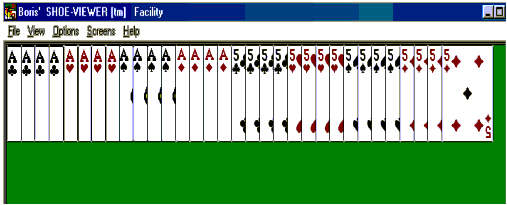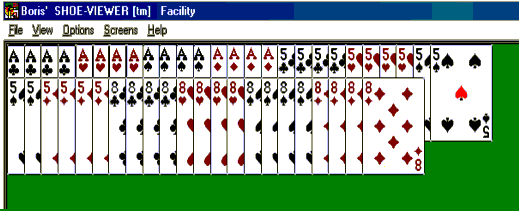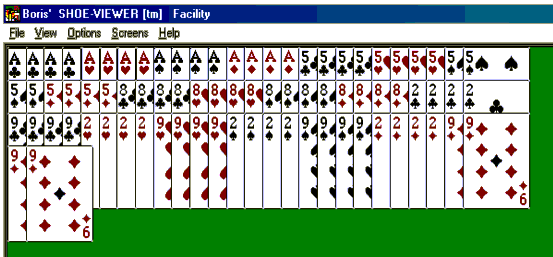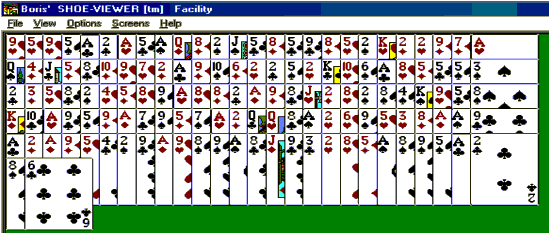
Practice Decks
How and Why to make them
Part I
Learning to drill the Boris
Ace-Five Count
Because I originally designed the Boris-for-Blackjack Computer Software to enhance my own play, periodically, I find myself back in practice play; as usual, combining live-dealt cards on top of VOLUME play with Boris. The final months of 2001 find this to again be true. This time, I am drilling a combination of the Boris Advanced Count (BAPC) and the (yet-to-be-released) Boris Clump-Track approach.
In 2001, current Boris users have watched the BJDRILLS.Exe program emerge from just a cute but useful little program, to a multi-faceted Drill Facility. Again, history repeats itself - Boris' has evolved to meet my immediate needs. Satisfied that doing drills has indeed improved my own play (my live-dealt play is routinely netting 10X Buy-in), these tools are being made available to the user-base in Boris Release 4.40. However, having a myriad of useful tools is worthless if you don't:
A) Know what tools you've got...
B) Know what to do with those tools.
What
to Drill - Simple or Complex?
There is a myth that Multi-parameter card-count methods automatically represent a superior approach, because the +/- values are designed to minutely mirror the differences each card contributes to the game. The myth also suggests that in like-wise, memorizing 140+ Hit/Stand decisions will allow you to "properly" play ANY hand, at ANY time - with confidence, no less.
It is important to realize that count-methods which are more complex may not translate into increased profits during actual play. The reasons for this are probably many; however a significant factor is the inevitable increase in error-rate as the procedure becomes more complex. Even Ken Uston himself eventually recognized the UAPC to be an "inferior" count (in comparison to the Uston Simple Plus-Minus). He confirmed this realization in his final book Ken Uston on Blackjack (1):
"When my mentor, Al Francesco, started his team, the highest powered system available was the 14 Count. Since that time. I'd developed a system, called the Uston Advanced Plus/Minus, which did not require Ace-adjustment. I erroneously suggested to readers, in my Million Dollar Blackjack that this system was inferior to the Uston APC.
I no longer feel that way. Because of the complexity of the Uston APC and the need to adjust for Aces in betting, I now believe the Advanced Plus/Minus to be a far more practical count.
This does not imply that the Uston Advanced Plus/Minus is the only effective system. In fact one of the best today is Arnold Snyder's Zen Count, which assigns a minus value to Aces, and does not require Ace-adjustment for betting purposes."
Additionally, winning at Blackjack requires that you master a number of different skills, including (but not limited to): Table Selection/Departure --- Card/Clump-Tracking --- Betting --- Playing the Hands --- Money Management --- Self-Management.
Most Blackjack Drill programs tend to focus on learning to count the cards and drilling the play of the hands; both important but far from a complete training-regimen. At best these drill approaches help you learn to keep a running/true count using random cards and complete decks.
Boris' BJDrills facility
now covers the other side of BJ Drilling as well, by offering the
ability to drill against random cards, casino-shuffled cards, and
"decks" that you specially make up (a .Cards file in Boris-parlance).
With Boris'
Design-a-Shoe™ Facility, we can now make Custom Practice Decks
(.Cards files) until we are sick of them.
The need for specially-configured practice "decks" was brought to my attention years ago in Ken Uston on Blackjack (2), where he said:
"...Bob, Robert and I dealt a few more hands. I hand-picked some complicated split and re-split pair hands, and a lot of insurance calls. Then I gave Robert $5,000, and sent them off to play the single-deck game at the Marina.
Now it was my time to practice.
I'd been spending my spare time training intensely. I personally practiced by putting together what I call a "Plus 24 deck", a special deck with extra 4's, 5's, 7's and 9's, and 8 Aces - to make it more difficult to "count it down". It was like swinging two baseball bats, instead of one, in the on-deck circle."
Because the Boris Advanced
Count (BAPC) originally evolved from what I deemed to be the
"flaws" of the Uston APC (as I have said, it is essentially
too complex for accurate, reliable play), it didn't take me long to
adapt the "two-bat" approach to learning the BAPC. While
Kenny is a little vague in the above description (i.e. how many cards
constitute "extra" cards?), I surmised what a useful
equivalent would be for the Boris Advanced Count.
In Part II of this article
series, we will make up a "Plus 24" Practice-Deck.
Regardless of what counting method you utilize, a two-bat approach to drilling can be applied; the only difference being the value YOU assign to each of the cards during the counting process. I.e., regardless of which count method you use, Aces are STILL the most player-favorable card in the deck and Fives are STILL the most dealer-favorable card - some things don't change.
Learning
in "Stages"
Learning any new skill
should be accomplished in bite-sized, gradient stages. Card-count
drills easily fit this requirement.
While I personally favor
using a medium-complex count method (the BAPC), it is nevertheless
best learned in stages.
Toward that end, I devised
what is known as the Boris Ace-Five count as a stepping-stone towards
learning the BAPC.
Most Ace-Five counts use
+1(Fives) and -1(Aces) respectively to keep a running-count. Because
the BAPC rates the Aces and Fives at -3/+3 (respectively), I have
chosen to use those values for the Boris Ace-Five count. Again,
remember, this count was designed as a spring-board to more advanced
training, not as a complete method unto itself.
Then again, the Boris
Ace-Five count is not only as easy to learn/execute as a traditional
Ace-Five count, it is also more accurate; thanks to
"weighting" the tracked-cards more accurately.
Drilling Boris' Ace-Five
count helps prepare you for Multi-parameter counts such as the UAPC,
BAPC and Zen Counts.
Because the Aces and Fives
are rated based on the BAPC, there is no unlearning or relearning
necessary should you decide to move up to the Boris Advanced Count.
Learning
the Boris Ace-Five Count
Now that we have spent some
time with the question of complexity, lets begin essentially at the beginning.
This "Beginning"
will serve as a solid foundation later, if you should decide to
upgrade your play.
The "Beginning" in Blackjack is to recognize that the Ace is the most player-favorable card and the Five is the most dealer-favorable card. That being found to be true, we can then devise a simple +/- card-count system to track Aces in contrast with 5's. Using a +/- system eliminates the need to compute a ratio (such as a tens-ratio) during actual play.
Because this is an article on Drilling in general (remember?) our purpose is NOT to learn the Boris Ace-Five method in its entirety, but to learn how to Drill (no matter what method is used) and how to make up Practice Decks to support that effort. The Boris Ace-Five Count rates cards as follows:
|
Card Value |
Count Point-Value |
|
Aces |
-3 |
|
Fives |
+3 |
|
All other Cards |
0 - (Ignored) |
As you can see, this is a Balanced-count using larger-than-normal values to track the cards. Because Aces/Fives are the most important cards in the deck, that importance needs to be reflected in the count, accordingly. The Boris Ace-Five Count accomplishes this in a compromise-manner (compared to the BAPC).
Making
an Ace-Five Deck
Because the Ace-Five Count tracks only Aces and Fives, utilizing regular decks of cards has been shown to be questionably- productive in drilling Ace-Five methods. What is needed is a deck of cards specially designed to properly drill the Ace-Five count - enter Boris' Design-a-Shoe™ Facility.
With Design-a-Shoe,™
we can make up one or more .Cards files contain the "extra"
Aces and Fives Kenny was talking about.
For my personal drilling
exercises, I began with a bare-bones Ace-Five practice deck
consisting of 16-Aces and 16-Fives.
If you don't sport a copy
of Boris' Design-a-Shoe™ Facility (it's available online as
Freeware and Shareware), you can make up practice decks by purchasing
a dozen or so decks of cards and extract the cards you need. Used
casino decks are ideal for this. Save the rest of the cards from each
deck as they can be utilized later to make up other kinds of practice
decks, or at least to "extend" the current ones. In the
Drilling steps, we will see how this is done.
The different .Cards files
I used to accomplis each of the to-be-described steps are shown at
the end of this article.
ACE-FIVE
Drilling
We begin with a pack of
cards which consist of nothing more than 16-Aces and 16-Fives,
putting the cards in alternating Ace-Five order. Deal the cards out
one-at-a-time and then repeat the deal (using the same card order) 2
cards-at-a-time. In BOTH cases, notice how the Aces and Fives cancel
each other out.
As you can see, the above
approach increases in complexity along a reasonably smooth gradient;
and then finally, takes off.
If you wish, you can add a 7th
and Final step:
For Step #7, take a complete deck of cards and riffle it INTO the 80-card Practice-Deck used in Step 6, counting it down as before. This 2 ½ decks more closely resembles live-action play; especially if you utilize a consistent series of casino-style riffles to shuffle the cards each time.
As you can see from the
above 7-step process, we have indeed fulfilled Kenny's recommendation
of swinging "multiple bats" in the on-deck circle.
In Part II of this article,
we will take a further look at this idea of making up special decks
in order to correct counting mistakes you may have trouble working-out.
While I am partial to using
Boris for card-drilling, like with Blackjack play, Boris is good for
VOLUME practice/play. Dealing live cards is also ALWAYS suggested.
Because your Practice-Deck
is "portable", you can run your count-drills almost
anywhere; something not always possible when using .Cards files.
As you can see, there is a
time and a place for BOTH methods - whatever it takes to become an expert.
Wrapping
it all up
This article has been about how to learn a simple counting method and how to Drill it. This article is NOT about how to BET the Count. However, I will say that people tend to keep card-counts with the idea of betting higher in +Counts and lower in -Counts. While this kind of counting has some flaws in today's shoe games, there are ways to bet the count to take advantage of today's non-random shuffle procedures. How to do all this is a discussion for another article - Stay Tuned.
Go ahead - make up your own practice decks. Practice time awaits!
The Basic Ace-Five Practice-Deck

The Ace-Five-Eight Practice-Deck

The Complete Ace-Five Practice-Deck

A Deck of cards shuffled
into an Ace-Five Deck
